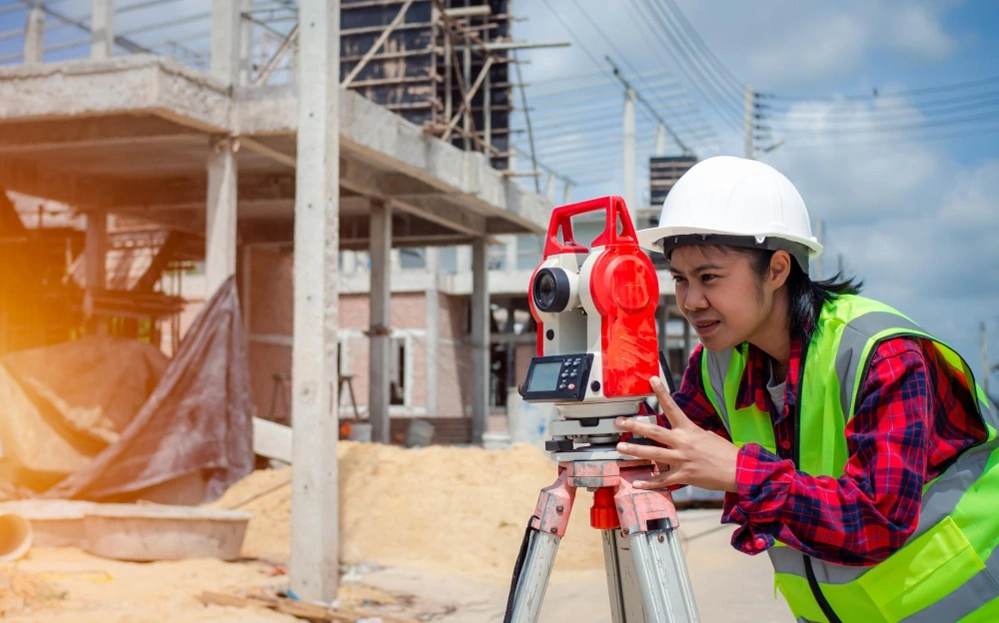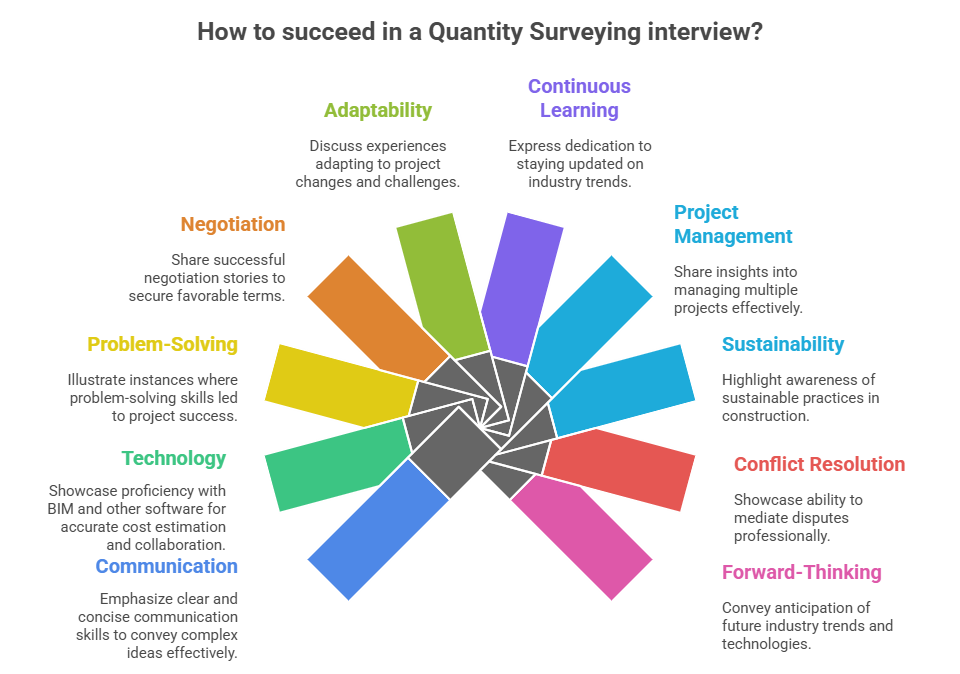Table of Contents
Are you preparing for a Quantity Surveyor (QS) interview in 2026? Whether you are a fresh graduate or an experienced professional, having a good understanding of the key QS concepts, industry trends, and practical scenarios can make all the difference.
In this blog, we shall critically go through some of the frequently asked Quantity Surveyor interview questions and expert answers so that you will stand out among the rest. From cost estimation and contract management to project budgeting, this guide covers everything about software skills necessary to ace your QS interview.
Let’s dive in!
Start Your Journey To A Prosperous Career ! Study Quantity Surveying With Professional Mentors!
Quantity Surveyor: Significance
In the dynamic landscape of construction and project management, Quantity Surveyors wield significant influence. Their role extends beyond mere number-crunching, encompassing a strategic and nuanced approach to cost estimation, financial oversight, and overall project success.
- As the construction industry adapts to new technologies, sustainability imperatives, and changing market dynamics.
- Quantity Surveyors become pivotal players, guiding projects through the intricate web of budgets, regulations, and client expectations.
- With the onset of 2026, the construction industry continues its trajectory of innovation and adaptation.
- Employers seek candidates who not only bring a foundational understanding of Quantity Surveying principles but also a keen awareness of the latest industry trends and methodologies.
- Preparing for interviews becomes a multifaceted endeavor, necessitating a deep dive into both traditional practices and emerging technologies that shape the contemporary landscape of construction management.
Quantity Surveyor: Top 25 Interview Questions
1: What is the main purpose of a Bill of Quantities (BoQ)?
1. What is the Role of a Quantity Surveyor in a Construction Project?
A Quantity Surveyor plays a crucial role in managing the financial aspects of construction projects. From initial cost estimation to project completion, they ensure that the project stays within budget while maintaining quality standards. Their responsibilities include preparing cost estimates, managing contracts, and overseeing expenses to prevent cost overruns.
Real-World Example: In a recent commercial building project, I conducted a detailed cost analysis, assessing material costs, labor expenses, and potential risks. This meticulous planning enabled the project team to stay within budget, ensuring financial efficiency and project success.
2. How Do You Approach Cost Estimation for a Construction Project?
Cost estimation is a structured process that involves analyzing project requirements, materials, and labor. I start by conducting a thorough quantity takeoff, followed by evaluating industry-specific factors such as market conditions, location, and project complexity. Utilizing advanced estimating software enhances both accuracy and efficiency.
Real-World Example: Keeping up with industry trends is vital. Leveraging technologies like Building Information Modeling (BIM) enables precise cost estimation through 3D project visualization, improving financial planning and reducing errors.
3. What is Value Engineering in Quantity Surveying?
Value Engineering optimizes project costs without compromising quality. This involves identifying cost-effective alternatives to enhance value while meeting project objectives.
Success Story: In a recent project, I recommended alternative materials that met the same quality standards but were more budget-friendly. This approach resulted in significant cost savings without sacrificing structural integrity.
4. How Do You Manage Project Scope Changes?
Managing scope variations requires clear communication and proactive financial planning. I collaborate with stakeholders to assess the impact of changes and adjust budgets and timelines accordingly.
Real-World Example: When a client requested modifications midway through a construction project, I swiftly evaluated the impact, communicated with the project team, and revised the budget to accommodate the changes without exceeding financial constraints.
5. Why is Risk Management Crucial in Quantity Surveying?
Risk management helps identify, assess, and mitigate potential project risks, ensuring smooth execution and financial stability.
Real-World Example: In a large-scale infrastructure project, I identified possible weather-related delays and incorporated contingency plans into the budget. This preparation helped minimize disruptions and kept the project on track.
6. How Do You Stay Updated on Industry Regulations?
Continuous learning is key. I attend industry conferences, enroll in professional courses, and engage with industry forums to stay informed about evolving regulations and best practices.
Pro Tip: Joining professional organizations and subscribing to industry publications provide valuable insights into regulatory changes and market trends.
7. What is Your Experience with Building Information Modeling (BIM)?
BIM is a game-changer in Quantity Surveying, offering enhanced accuracy in cost estimation and project planning through 3D modeling.
Personal Experience: Using BIM in a recent project streamlined the quantity takeoff process, improving cost estimation accuracy and enhancing collaboration among stakeholders.
8. How Do You Ensure Effective Communication with Clients and Contractors?
Clear communication is crucial for project success. I maintain open channels through regular updates, detailed reports, and transparent documentation.
Real-World Example: By providing consistent financial reports and addressing concerns proactively, I fostered trust among stakeholders, ensuring smooth project execution.
9. How Do You Handle Disputes with Contractors?
Resolving disputes requires open dialogue, negotiation, and mediation. I focus on finding solutions that align with project goals while maintaining positive relationships.
Personal Experience: In a contract dispute, I facilitated a discussion that clarified expectations and revised project plans accordingly, preventing costly delays and disputes.
10. What is Life Cycle Costing in Construction?
Life cycle costing evaluates a project’s total expenses, including initial, operational, and maintenance costs, ensuring long-term financial sustainability.
Example: In a sustainable project, I recommended eco-friendly materials that, despite higher initial costs, offered significant long-term savings and environmental benefits.
11. How Do You Manage Unexpected Cost Overruns?
Regular budget monitoring, risk assessments, and contingency funds help address unexpected expenses efficiently.
Real-World Example: In a project where labor costs increased due to delays, a pre-established contingency fund covered the additional expenses, preventing financial strain.
12. What Role Does Sustainability Play in Quantity Surveying?
Sustainability is vital in modern construction. Quantity Surveyors assess eco-friendly materials and energy-efficient designs to promote cost-effective sustainability.
Example: In a LEED-certified project, I analyzed the cost-benefit of green materials, balancing sustainability with financial viability.
13. How Do You Negotiate Contracts with Suppliers?
Thorough market research, relationship-building, and bulk purchasing strategies help secure cost-effective contracts.
Success Story: Negotiating bulk discounts on materials saved a project significant costs, improving overall financial efficiency.
14. Can You Share a Cost-Saving Success Story?
Case Study: By collaborating with engineers to refine a structural design, we reduced material and labor costs by 15%, significantly enhancing project profitability.
15. How Do You Ensure Accuracy in Quantity Takeoffs?
Using advanced estimating software, conducting thorough cross-checks, and staying updated on measurement standards ensure precision in takeoffs.
16. How Do You Adapt to Technological Advancements in Quantity Surveying?
Embracing tools like AI-driven estimating software and BIM enhances efficiency and accuracy in cost management.
Example: Integrating estimating software streamlined my workflow, reducing errors and improving cost assessments.
17. How Do You Manage Multiple Projects Simultaneously?
Effective time management, project tracking software, and task prioritization ensure smooth handling of multiple projects.
Example: Managing three concurrent projects successfully required structured workflows, clear delegation, and proactive problem-solving.
18. How Do You Handle Tight Deadlines in Construction Projects?
Strategic planning, identifying critical path activities, and proactive stakeholder communication are key to meeting deadlines.
Real-World Example: By implementing phased construction, I ensured early completion of critical tasks, keeping the project on schedule.
19. What is the Future of Quantity Surveying with Technology?
AI, machine learning, and data analytics will drive efficiency, automating routine tasks and enhancing strategic decision-making.
Future Outlook: Advanced technologies will empower Quantity Surveyors with predictive analytics, optimizing cost forecasting and project management.
20. Do You Have Any Questions for Us?
Demonstrating curiosity about the company’s projects, sustainability initiatives, and technological adoption showcases a candidate’s enthusiasm and alignment with the organization’s vision.
Examples of Questions to Ask:
- How does your company integrate sustainability in construction projects?
- What are the latest technologies your firm has adopted in project management?
- Can you share a recent success story where Quantity Surveying played a crucial role?
21. How do you perform rate analysis for a construction activity?
Rate analysis involves breaking down the total cost of a work item into material, labour, equipment, and overhead costs. For example, in concrete work, I calculate the quantity of cement, sand, and aggregate needed, factor in labour hours, add equipment costs, and include a percentage for profit and overheads.
22. Explain the term ‘Variation’ in a construction contract.
A variation is any change to the scope of work specified in the contract. It can involve additions, omissions, or substitutions. Variations usually affect cost, time, or both, and must be documented and approved before implementation.
23. How do you handle disputes related to payments or contract terms?
I rely on clear documentation, BoQs, contracts, site reports, and correspondence. I first attempt negotiation between parties, and if unresolved, recommend formal dispute resolution methods such as adjudication or arbitration.
24. How do you prepare a Bill of Quantities (BOQ)?
Preparing a BOQ involves listing all project items, quantities, and unit rates based on drawings and specifications. I start by reviewing architectural and structural drawings in AutoCAD to extract quantities, such as 500 tons of steel or 1,000 m² of flooring. Next, I apply current market rates (e.g., ₹80/kg for steel in India) using IS codes or CPWD schedules. I organize the BOQ in Excel, categorizing items like concrete, reinforcement, and finishes, and include contingencies (5–10%).
25. What’s the importance of a Tender Analysis?
Tender analysis helps compare contractor bids in terms of cost, scope, and compliance with specifications. This ensures selection of a bid that offers the best value for money without compromising quality.
|
Engineering Upskilling Courses
|
| MEP Course |
| BIM Course |
| Quantity Surveyor Course |
| Structural Design Course |
| MEP QS Course |
Master Quantity Surveying – Build a Rewarding Career Today!
Gain in-demand skills in cost estimation, project budgeting, and contract management with our Quantity Surveying Course. Learn from industry experts and boost your career in construction and infrastructure. Enroll now and take the first step toward success!
Know MoreQuantity Surveyor: Tips for Interview Success
Beyond question and answer breakdowns, this blog offers practical tips tailored to each facet of Quantity Surveying. These insights are not only geared towards interview success but also provide a roadmap for effective performance on the job. From negotiating contracts to managing tight deadlines, candidates will garner actionable strategies that extend beyond the interview room.
Mastering the Art of Clear Communication:
- In quantity surveying – effective communication is literally everything.
- When you’re in the interview, show off your ability to break down complex ideas into simple, clear language.
- Make sure to hammer home the importance of being transparent with your clients, contractors, and everyone else involved.
Showcase Your Technological Savvy:
- Show them you’re up to speed with all the latest tech tools used in the trade.
- Highlight any experiences you have with software like BIM, advanced estimating tools and project management software.
- Explain how you use tech not just to get the numbers right but also to make the whole process more collaborative and easier to manage.
Emphasise Your Problem-Solving Skills:
- Tell them about the times when your problem-solving skills really paid off.
- As a quantity surveyor you’ll be dealing with all sorts of issues – cost estimation, risk management, project scope changes.
- Find real-world examples where you were able to analyse a situation, propose a solution and then roll with the punches when things got tough – and how that all contributed to a successful project.
Highlight Your Negotiation Tactics:
- Negotiation is a big part of being a quantity surveyor – whether it’s contracts, suppliers or subcontractors.
- Share some war stories that show off your negotiation skills – where you were able to get a good deal without compromising on quality.
- Show how you can find solutions that work for everyone – solutions that align with what the project needs.
Demonstrate Your Ability to Adapt to Change:
- In construction, things are always changing, so being able to roll with the punches is essential.
- Think about times when you successfully managed changes to the project scope, or when unexpected challenges came up.
- Show how you can adjust your approach to fit the changing needs of the project – how you stay flexible and get things done.
Prove That You’re Committed to Learning:
- Make it clear that you’re interested in staying up to date with the latest industry developments.
- If you’re involved in any ongoing training or professional development – let them know about that too.
- Show how you ensure you stay on top of your game in a industry that’s always changing.
Showcase Your Project Management Prowess:
- As a quantity surveyor you’re often managing lots of projects at once.
- Share your strategies for managing multiple projects, including how you use tools and delegate tasks.
- Use examples to show how you successfully juggled lots of different projects, keeping them all on track and meeting deadlines.
Illustrate Your Commitment to Sustainability:
- It’s really important to have a green mindset when it comes to construction projects.
- Think about times when you’ve contributed to sustainable decisions, without sacrificing project efficiency.
- Explain why sustainability matters to you – and how you incorporate it into your work as a quantity surveyor.
Show That You Can Resolve Conflicts Effectively:
- Conflicts will arise, no matter how hard you plan.
- Share times when you’ve successfully mediated disputes and kept relationships positive.
- Show how you can handle conflicts in a way that’s fair and constructive – and that keeps the project on track.
Look to the Future:
- Use this interview as a chance to talk about how you see the industry evolving in the future.
- Share your thoughts on new technologies, sustainability and what you think will be important in the years to come.
- Leave them with the impression that you’re not just ready for the challenges of today, but also for the innovations and changes that are coming.
Why Choose Entri’s Quantity Surveying Course for Interview Prep?
Entri’s Quantity Surveying Course prepares candidates for interviews and QS roles:
- Modules: BOQ preparation, cost estimation, contract management, value engineering.
- Tools: PlanSwift, Primavera P6, Excel, BIM (Revit).
- Benefits: Affordable fees, flexible online classes, RICS-aligned certification.
- Interview Prep: Mock interviews, resume-building, and placement support for 12,000+ jobs in India and GCC countries.
- Access: Ideal for engineers in Kerala or the Middle East.
Final Thoughts
Landing a Quantity Surveyor job requires technical expertise, cost management skills, and strong communication. The questions above cover the most common topics that employers look for during interviews.
To gain a competitive edge, consider pursuing industry-recognised QS certifications and practicing with mock interviews. Your ability to combine theoretical knowledge with practical application will set you apart from other candidates.
Moving forward, the guide also explores future industry trends such as BIM and sustainability. This will inspire candidates to be innovative and embrace continuous learning, thus equipping them with knowledge that they can confidently take into interviews and contribute to the changing world of Quantity Surveying.
Master Quantity Surveying – Build a Rewarding Career Today!
Gain in-demand skills in cost estimation, project budgeting, and contract management with our Quantity Surveying Course. Learn from industry experts and boost your career in construction and infrastructure. Enroll now and take the first step toward success!
Know MoreFrequently Asked Questions
Q1. What are the key skills required for a Quantity Surveyor?
Ans: A Quantity Surveyor needs strong analytical skills, attention to detail, proficiency in cost estimation, contract management, negotiation skills, and expertise in construction technologies like Building Information Modeling (BIM).
Q2. What software should a Quantity Surveyor be familiar with?
Ans: Common software used in Quantity Surveying includes: BIM (Building Information Modeling) – for 3D visualization and cost estimation AutoCAD – for project drawings and measurements Microsoft Excel – for cost analysis and budgeting CostX – for quantity takeoff and cost planning Primavera P6 / Microsoft Project – for project scheduling and management
Q3. How do I prepare for a Quantity Surveyor interview?
Ans: Review key QS concepts such as cost estimation, tendering, contract types, and risk management. Brush up on industry regulations and sustainability practices. Be ready to discuss real-world experiences and problem-solving scenarios. Practice with common interview questions related to the role. Familiarize yourself with latest industry trends and technologies.
Q4. What is the difference between a Quantity Surveyor and a Cost Estimator?
Ans: A Quantity Surveyor manages overall project costs, contracts, and financial planning, whereas a Cost Estimator primarily focuses on calculating the estimated cost of a project before construction begins.
Q5. How do Quantity Surveyors contribute to sustainability?
Ans: Quantity Surveyors help select eco-friendly materials, evaluate life cycle costs, and implement energy-efficient practices to minimize environmental impact while maintaining cost efficiency.
Q6. What is a Bill of Quantities (BOQ), and why is it important?
Ans: A BOQ (Bill of Quantities) is a document that lists all materials, parts, and labor required for a construction project. It helps in cost estimation, budgeting, and tendering, ensuring transparency and cost control.

























